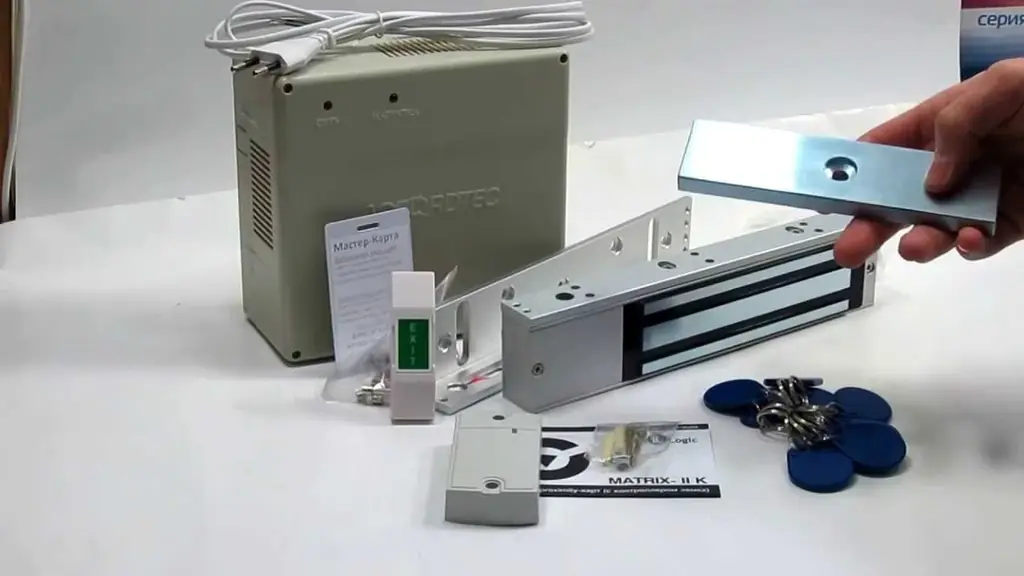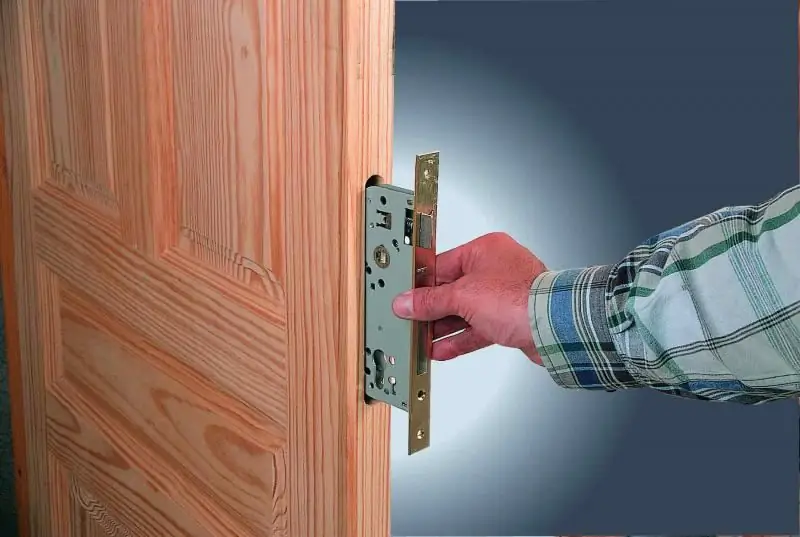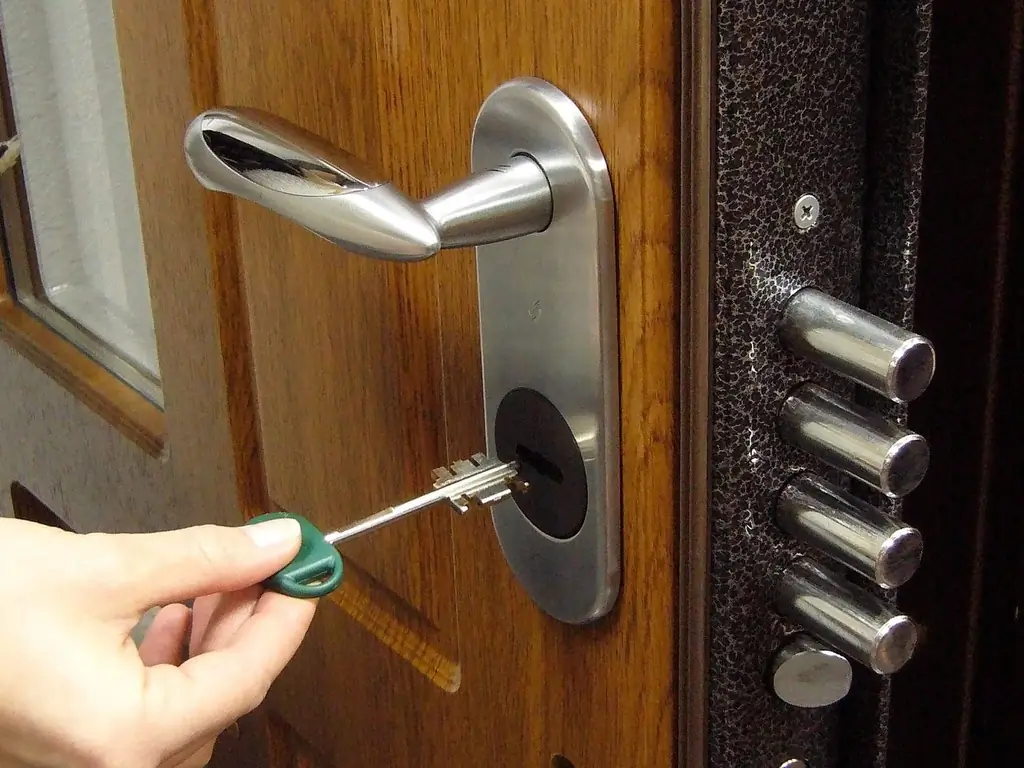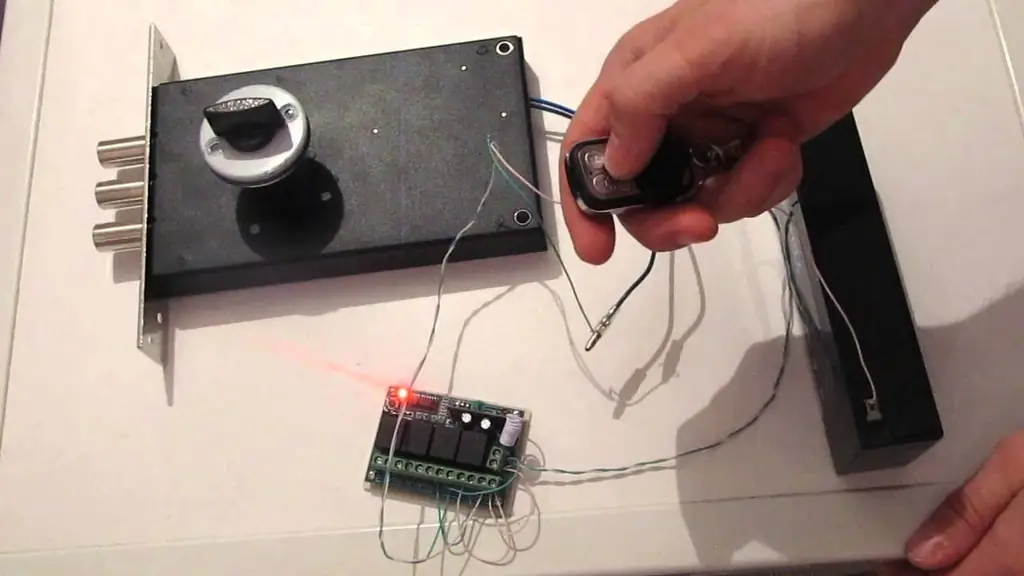
Table of contents:
- Author Bailey Albertson [email protected].
- Public 2023-12-17 12:53.
- Last modified 2025-06-01 07:32.
Electromagnetic lock: varieties, features of installation, repair and operation

One of the options for protecting the door of a room or fence from unauthorized opening is to install an electromagnetic lock. Such a device is installed directly on the door, and it is controlled remotely using an electrical signal. Electromagnetic locks are very popular due to their high reliability and work well both indoors and outdoors.
Content
-
1 The device and principle of operation of electromagnetic locks
- 1.1 Internal structure
- 1.2 Advantages and disadvantages
-
2 Varieties of electromagnetic locks
- 2.1 Locks with controller
- 2.2 Electromagnetic holding locks
- 2.3 Shear type locks
- 2.4 Coded electromagnetic locks
- 2.5 Video: overview of different types of electromagnetic locks
-
3 Installation of an electromagnetic lock
3.1 Video: installing an electromagnetic lock with your own hands
-
4 Repair of electromagnetic locks
4.1 Video: repair of an electromagnetic lock
- 5 Operating tips
- 6 User Reviews
The device and principle of operation of electromagnetic locks
Although electromagnetic locks from different manufacturers may differ in design, the principle of operation is the same. The door closes and opens thanks to the presence of an electromagnet inside the device. You can control such a locking device by pressing a button or by entering a special code.
The quality and reliability of the lock will depend on the strength of the electromagnet used. The larger it is, the more securely the metal plate holding the doors is fixed.
In the event of a sudden power outage, the electromagnetic lock will not be able to fulfill its direct purpose, therefore it is recommended to additionally install an autonomous power supply or a conventional mechanical lock

The reliability of fixing the door with an electromagnetic lock depends on the holding force of the built-in magnet
To ensure reliable protection of a house, industrial enterprise or territory, an independent energy source must be installed to control the electromechanical lock. In the event of a main power failure, the system automatically goes into offline mode, so nothing will threaten the safety of the house.
The principle of operation of an electromagnetic lock is simple and straightforward. The main part with a magnetic device is fixed directly on the door frame and is powered from a constant voltage source. The striker plate is attached to the door leaf. When power is applied, the electromagnet is triggered and the striker plate is attracted to it, which ensures reliable locking of the door. When you press the button that controls the lock, the power is turned off, after which the plate is pulled back, allowing the door to open.
Internal organization
The electromagnetic lock consists of the following elements:
-
Case - it has devices for secure fixation and is made of non-magnetizable material:
- of stainless steel;
- aluminum;
- plastics.
- The core is located inside the case and is made of a material that does not have a magnetic memory, due to which the control takes place promptly. It can be all-metal or assembled from W-shaped steel plates.
-
The winding is also located in the lock case and consists of several hundred turns of copper wire. During the passage of an electric current through the winding, a powerful electromagnetic field is created that reliably holds the core.

Electromagnetic lock design The main element of the electromagnetic lock is the winding - when an electric current passes through it, a magnetic field is created that attracts the striker
- An iron plate that provides a secure fixation of the door when closed.
- Electrical components. Typically, such locks have a bi-directional protective diode in their circuit, which makes it possible to reduce voltage surges that occur when the lock switches. Capacitors are installed to remove residual magnetization.
- The control system can be either a button or a special coded device or an electronic key.
To power almost any electromagnetic lock, a constant voltage of 12 V is required. It may vary slightly, but this is undesirable. If the voltage drops, the holding force of the electromagnet decreases and the reliability of the lock also decreases. When the voltage rises, the winding overheats, which can lead to its failure. High-quality modern electromagnetic locks consume only a few watts, so their installation will not greatly affect the overall energy consumption.
Advantages and disadvantages
Electromagnetic locks have many advantages, which explains their great popularity:
- long service life - on average 10-15 years. Provided due to the absence of moving parts;
- a large selection of models. They can be cut-in, overhead, tear-off or shear;
- high reliability. Such a lock cannot be broken by drilling or picking;
- the ability to remotely control the process of opening / closing the door;
- the ability to install on any doors, including metal, plastic, wood, glass;
- easy installation and maintenance;
- the minimum power consumption is approximately 3-5 W;
- the ability to work both indoors and outdoors;
- affordable cost. A simple electromagnetic lock with a hold of 180-300 kg at retail costs 1000-1500 rubles.
Like any other type of lock, this locking device has its drawbacks:
- dependence on the availability of power supply in the network, therefore, for the reliable operation of such a lock, it is imperative to install an autonomous power supply;
- higher cost than a mechanical lock, which is justified by a significantly higher reliability and ease of use;
- the need to have certain skills in working with electrical networks for self-installation.
Varieties of electromagnetic locks
By design type, electromagnetic locks are:
-
Shear. The door is opened due to the lateral movement of the locking element. Such devices can be installed on any kind of doors, including those that open in both directions.

Sliding electromagnetic lock The principle of operation of the sliding lock is based on the lateral movement of the locking element
-
Retaining or tear-off. In such a device, the door is opened by tearing it off. The functionality of such locks is not impaired in case of deformation of the box or door leaf, as well as when the doors shrink.

Holding Electromagnetic Lock The retaining lock works by adhering the plate to the base of the body and holding it with an electromagnet
Depending on the way the door is opened, the locks can be:
-
overhead - mounted on canvases that open outward;

Surface mounted electromagnetic lock A surface-mounted lock is mounted on a door that opens outward
-
mortise - they are installed on doors that open inward.

Mortise electromagnetic lock The mortise lock is mounted on doors that open inward
The choice of the holding force of the electromagnet will depend on the type of door leaf:
- for internal doors, a holding force of about 200-300 kg is quite enough;
- for massive metal doors this force should be greater - 350-500 kg.
By type of application, electromagnetic locks are:
- individual. Such devices are installed in private houses, apartments, offices, etc.;
- public. They are used in shops, offices, banking institutions, porches, etc.
Locks with controller
To ensure control of the electromagnetic lock and to be able to connect additional equipment to it, such as a reader, card or key fob, an opening button, a buzzer, a controller is installed on it. To protect the controller from the negative effects of external natural factors, it must be placed in a special protective case.
Electromagnetic locks with a controller are highly reliable, therefore they are usually installed in rooms where high requirements are imposed on the lock. These can be entrance doors to any room, fire and emergency exits, etc.

An electromagnetic lock with a controller is installed in a room where high requirements are imposed on the locking device
Modern locks with a controller have the following characteristics:
- light and sound indication;
- blocking when selecting a key;
- memory capacity of 500 or more keys;
- protection against freezing and jamming;
- nonvolatile memory;
- programmable door opening time - 1-15 s;
- protection against high voltage input;
- the ability to copy memory from / or to a computer.
Holding electromagnetic locks
The peculiarity of the retaining locks is that during their installation special accuracy is not required and they are easy to adjust. The main advantage of holding electromagnetic locks is that their operation is practically not affected by the state of the door. Due to their simple design and reliability, such locks are widely used and are usually used in places of mass presence of people when it is necessary to close / open doors frequently.
Usually, retaining locks are installed in the upper part of the door, which can lead to undesirable deformations on lightweight and fragile door leaves. In addition, their design is subject to the phenomenon of remanent magnetization. Therefore, experts do not recommend using holding-type devices on canvases that open inward or in both directions.

The retention lock does not require high precision and is easy to adjust
Shear locks
Such a lock works by sliding a flat anchor. The main advantage of such models is that they can be installed inside the door frame or door leaf. And the disadvantage of such structures is the need to accurately observe the gap between the interacting parts of the lock.

Sliding lock can be installed inside the door frame
There are several main parameters that you need to pay attention to when choosing and operating a sliding electromagnetic lock:
- shear load, it can be from 100 to 1200 kg;
- retention strength;
- the degree of security (secrecy);
- residual magnetization - when opening the door, the force should not exceed 2 kg. If this value is greater, the lock must be repaired.
Coded electromagnetic locks
Their main difference from other types of locks is the presence of a code keyboard, which can also have a card / key fob reader. Thanks to this device, you can open the lock in several ways:
- by dialing a special code;
- by dialing a code + card;
- card or key fob.
The combination lock, like other electromagnetic models, meets the fire safety rules, since when the power is turned off, the door is automatically opened. Since there are no rubbing parts in the design of such a lock, it has a long service life and is usually installed in rooms that are visited by 20 or more people a day.

The coded electromagnetic lock has a keypad for entering a user identification code
When choosing an electromagnetic lock, you should pay attention to the following criteria:
- Door leaf type.
- Terms of Use. If the lock will be used outdoors, then it must be protected from the negative effects of moisture, not be afraid of temperature changes.
- Installation method.
- Availability of an alternative power source. If it is not possible to provide autonomous power supply, then in the absence of electricity, the lock automatically opens.
- Retention strength. The larger and more massive the doors, the greater the holding force of the electromagnet must be.
Video: an overview of different types of electromagnetic locks
Installation of an electromagnetic lock
If you have basic locksmith skills and you know how to work with electrical circuits, then it is not difficult to install such a lock yourself. Before starting work, you need to decide on the following parameters:
- how the canvas and the box are located - the box can protrude or be flush with the canvas;
- where the doors open - inward or outward.
The most common option is when the door frame has a projection from the edge of the leaf in the closed state with a width of 5-6 cm and it opens outward. In this case, there are no problems with self-installation of the electromagnetic lock, but first you need to purchase all the necessary tools:
- electric drill with a set of drills;
- pencil;
- measuring instruments;
- fasteners;
- screwdriver;
- building level;
-
wire strippers or a sharp knife.

Electromagnetic Lock Installation Tools The necessary tools for installing an electromagnetic lock can be found in every home craftsman.
The process of installing an electromagnetic lock is divided into two stages: mounting the striker and the magnet itself. The sequence of work will be as follows:
-
Installation of a striker. Usually, the set of the electromagnetic lock along with the striker has a template for its installation. First, they determine the place of attachment - it is necessary that the bar hit the electromagnet when the door is closed. After that, a stencil is applied to the door leaf and holes for the bolts are made. Then, using fasteners, the striker is fixed, while rubber washers are installed between it and the canvas. The strike plate should be able to move a little, this is ensured by rubber washers, with the help of which it can take the required position relative to the electromagnetic lock.

Installing a striker The strike plate must precisely come to the electromagnet when the door is closed, therefore it is installed on rubber washers for adjustment
-
Unscrew the locking screws on the lock. Using the hex key that usually comes with the lock, unscrew the screws that secure the lock bar.

Electromagnetic lock fastening bar The fixing strip is used to fix the lock on the door using bolts, it is supplied screwed to the body
- On the canvas opposite the striker, mark the place for mounting the magnet.
-
The flat mounting plate of the lock is securely fixed to the box.

Fixing the lock bar The lock bar is fixed on the box using self-tapping screws
-
The magnet is attached to the bar in the reverse order - first with the help of a hexagon, after which the locking screws are screwed in.

Fixing the lock An electromagnetic lock is fixed to the bar installed on the box, and then the locking bolts are screwed in
- Check the correctness of the installation. The doors should close tightly, while the lock should not hit the strike plate.
-
Connect power and other electronic components in accordance with the diagram, which is in the instructions.

Electromagnetic lock connection diagram All connections of the components of the access control system under which the lock will operate are made according to the diagram included in the kit
In the event that the doors open inward and the door leaf is flush with the box, special mounting angles must be used to mount the lock.
-
If the door does not have a ledge, an L-shaped corner is used. The mounting of the striking plate is carried out as in the previous version, and the magnet is attached to the corner, which is installed on the box.

Installation of a door lock without a ledge On doors without a protrusion, the magnet is mounted on an L-shaped corner
-
If the door opens inward, then a ZL-shaped corner must be used. The lock to the box is fixed using the L-angle, and the striker to the door leaf - using the Z-angle.

Installation of a lock on doors opening inward On doors that open inward, the lock is fixed to the frame using the L-angle, and the striker is fixed to the Z-angle
Video: installing an electromagnetic lock with your own hands
Repair of electromagnetic locks
Although the electromagnetic lock has a long service life and high reliability, like any other equipment, after a while it can fail. The main factors that can lead to breakage of the lock:
- human - improper use of the castle;
- natural - the negative impact of external factors, which leads to damage to the wiring and fasteners.
The main breakdowns of the electromagnetic lock are associated with the weakening or disappearance of the holding force or with the appearance of residual magnetization. The force can disappear due to a break in the wires that provide power to the lock, a breakdown of the power supply, or with the failure of the solenoid coil.
The main malfunctions of the electromagnetic lock and how to eliminate them:
- Coil repair. To check the functionality of the coil of the electromagnetic lock, you need to use a tester. The resistance should be several tens of Ohms, it all depends on the model and power of the lock. If the resistance does not correspond to the parameters stated in the instructions, the coil is replaced, and if the unit is monolithic, then the entire magnet.
- Residual magnetization. It appears when a capacitor breaks down, which serves to create damped oscillations when the power is turned off, removing the remnants of the magnetic field. To eliminate such a breakdown, it is necessary to connect a 25 V capacitor in parallel to the terminals of the lock. For most domestic locks, a capacitor of 220 μF is sufficient, and for foreign models, the capacity can be from 220 to 1000 μF and is selected individually.
- Coil break. The indicated malfunction is eliminated by replacing the coil or restoring its operability in specialized workshops.
Video: repair of an electromagnetic lock
Operating tips
If the electromagnetic lock was installed correctly, then during its operation usually no problems arise. You just need to adhere to simple rules for the care of the equipment:
- during operation of the lock, it is necessary to periodically check the condition of the plate. Under the influence of moisture, plaque can appear on it, which leads to a weakening of the holding force;
- it is recommended to periodically check the fastenings of the lock and striker. Over time, under the influence of loads, self-tapping screws can weaken, so they must be periodically tightened;
- when using a lock with a controller implemented as a separate device, it is imperative to have a master key. It is used to encode cards. It is recommended to keep it in a back box to avoid encryption problems that arise if one of the users loses the access card. The controller itself is recommended to be placed in a sealed bag to protect it from moisture.
User reviews
Installing an electromagnetic lock provides increased security in your home, apartment or office. Such locking devices have high reliability, long service life and remote control. When choosing an electromagnetic lock, one must take into account the scope of its application. Remember that the security of your home will depend not only on the type of lock, but also on how correctly it is installed, as well as on the quality and reliability of the front door.
Recommended:
MDF Doors: Entrance And Interior Doors, Their Varieties With A Description And Characteristics, Advantages And Disadvantages, As Well As Installation And Operation Features

Doors from MDF: features, characteristics, varieties. Making and installing MDF doors with your own hands. Door restoration. Reviews, photos, videos
Mortise Lock For Wooden Doors: Design Features, How To Choose And Install Correctly

Types of mortise locks for wooden doors, their features and differences. Instructions for installing a mortise lock with your own hands. Recommendations for use
Door Locks For Metal Doors: Characteristic Of Varieties, How To Choose And Install Correctly

Varieties of locks for metal doors, their design, pros and cons. DIY installation of mortise and overhead locks. Maintenance and repair
Electromechanical Door Lock: Types And Design Features, How To Choose And Install Correctly

What is an electromechanical lock. Features of its device and existing types. Installation of an electromechanical lock, its repair and operation
Mortise Lock For Doors: Design Features, How To Choose And Install Correctly

Types of mortise locks and their design features. How to install a mortise lock in wooden and metal doors. Recommendations for the use of mortise locks
